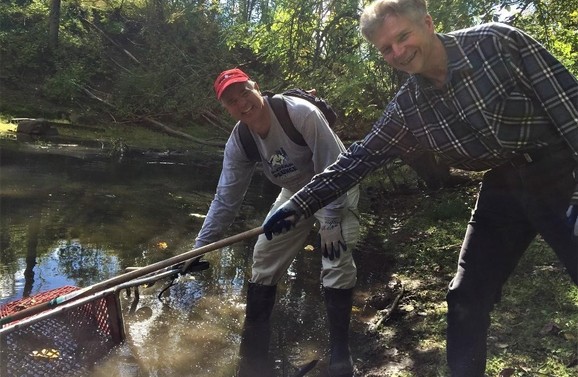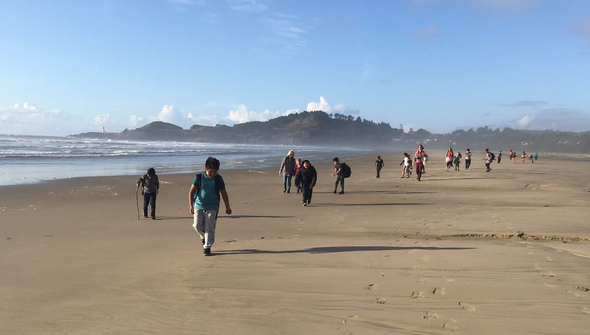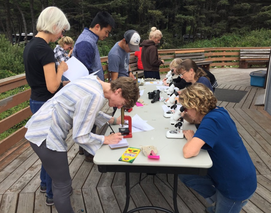November 2019 Update #5
Dear colleague,
In March 2019, over 30 representatives of the Oregon marine debris community convened for a workshop in Newport to update the Oregon Marine Debris Action Plan. The updated Action Plan, published in September 2019, includes a long list of accomplishments, a testament to the hard work and sustained efforts to reduce marine debris in Oregon. This newsletter update, the fifth since April 2017, is to share recent marine debris accomplishments in Oregon and other marine debris issues of interest.
Many thanks to everyone who contributed to this update.

Visit the Adopt-a-Beach website (Photo credit: SOLVE).
Submitted by: Jon Schmidt, SOLVE
SOLVE, in partnership with Oregon State Parks, is launching its newest coast-wide Adopt-a-Beach program, and is inviting community groups, families, and even individuals to sign up and adopt a beach. To receive support from SOLVE, program participants will be required to sign a two-year agreement committing to cleaning “their” beach at least three times a year. Supplies, mini-grants, training, and recognition on SOLVE’s website will be provided to participants. Program volunteers will be encouraged to submit reports to the SOLVE office and work with State Park staff to arrange for proper disposal of collected debris. The pilot project for this program was supported by the NOAA Marine Debnris Program and the National Marine Sanctuary Foundation. For more information and links to the program materials, see www.solveoregon.org/oregon-adopt-beach.
Derelict and abandoned vessels on the Columbia River (Photo credit: OSMB).
Submitted by: Dorothy Diehl, Oregon State Marine Board
In the months of March through September 2019, the Oregon State Marine Board (OSMB) coordinated or supported the removal of twenty-four abandoned or derelict vessels, twenty-three on rivers in the Columbia Basin and one on the Oregon Coast.
The summary above includes a September project on the Columbia River in which OSMB collaborated with the Department of State Lands (DSL) to seize and remove nine abandoned and/or derelict vessels from the North Portland Harbor. In the same area, DSL also partnered with the Port of Portland, the City of Portland, the Multnomah County Sheriff’s Office, Metro, and the Oregon State Police to remove unauthorized structures and encampments along the river. In addition to the nine vessels and numerous unauthorized structures, over eleven tons of waste was removed from Columbia River beaches as part of the cleanup effort.
Teachers dissect albatross boluses from Midway Island to identify natural and man-made items the birds consumed (Photo credit: Sara Roberts).
Submitted by: Kerry Carlin Morgan, Oregon Coast Aquarium
In August 2019, the Oregon Coast Aquarium and our partner, the Center for Geography Education of Oregon, began a year-long teacher institute with an intensive week of learning for the participants. Fourteen passionate Oregon middle school teachers, recruited through a competitive application process, engaged with guest speakers and hands-on activities covering seabird biology, oceanography, plastics, STEAM solutions, and facilitating meaningful student projects.
In October, the group embarked on a pelagic boat tour to search for albatross the iconic species highlighted to demonstrate marine debris impacts. In the spring, teachers will head to Hawaii to witness plastic impacts on albatross in their nesting grounds. Using what they learned and inspiration from their experiences, teachers will plan student projects that reduce or clean up plastics, ultimately protecting seabirds. Teachers will share their stories at the Aquarium’s World Ocean’s Day celebration in June.
 |
Volunteers removing a shopping cart from a High Rocks Park on the Clackamas River just south of Portland (Photo credit: SOLVE).
Submitted by: Jon Schmidt, SOLVE
SOLVE's Beach & Riverside Cleanup, in partnership with Oregon Lottery, was another huge success in September 2019. Over 5,500 volunteers removed more than 28,000 lbs of debris from 147 cleanups. Volunteers not only cleaned the majority of the Oregon coast's accessible beaches, they also cleaned lakes, rivers, and stream banks around the state. Taking a watershed approach, tons of litter were removed from neighborhood streets, parks, and natural areas. Many partners, sponsors, and hard-working volunteers contributed to the successful effort. The next coast-wide event, the Spring Oregon Beach Cleanup, will take place on Saturday, March 28, 2020.
If you are interested in participating as a Beach Captain or supporting the event in other ways, contact SOLVE’s Program Coordinator, Jon Schmidt at jon@solveoregon.org.
It is time to update and modernize Oregon’s recycling system (Photo credit: DEQ).
Submitted by: David Allaway, Department of Environmental Quality
Oregon Department of Environmental Quality (DEQ) and its partners are working together to update and modernize Oregon’s recycling system, which was heavily disrupted in 2017 and 2018 after international markets began restricting their acceptance of many materials. Although most domestic recycling programs do little to reduce marine debris, the U.S. and other countries had been exporting too much non-recyclable materials mixed in with our recyclables, and this may have contributed to marine debris in other nations. DEQ and other partners responsible for Oregon’s recycling system have been working together to identify what a future system should look like and in 2020 will recommend changes to achieve that future recycling system. Interested parties are invited to attend a meeting on January 31, 2020 to learn more about possible changes and opportunities to provide feedback on the future of recycling in Oregon. Sign up to receive updates on the project and January 31 meeting details here.
 |
HMSC summer campers on a beach cleanup (Photo credit: OSG).
Submitted by: Cait Goodwin, Oregon Sea Grant - HMSC Marine
Students share marine debris projects at symposium events. With NOAA B-WET funding, Oregon Sea Grant (OSG) ran three Student Watershed Symposium events in Spring 2019. Events in Newport (March), Charleston (April), and Astoria (May) reached 123 students from seven school districts, and were assisted by 13 partnering organizations. Many of the students had engaged in meaningful watershed educational experiences during the year that were focused on the problem of marine debris and had participated in stewardship actions such as beach cleanups, waste reduction activities at school, and civic engagement. At the symposium events, students shared the results of their projects with peers and community, and engaged in hands-on activities such as the upcycling plastics lesson from the NOAA Marine Debris STEAMSS curriculum.
Hatfield Marine Science Center summer campers explore marine debris. Of the four summer camps offered by OSG’s Marine Education program at Hatfield Marine Science Center (HMSC), one week-long offering focused on the topic of marine debris. Using the “Beach Box” lesson from the NOAA Marine Debris STEAMSS curriculum, twenty 11-12 year old campers first explored, defined, and sorted marine debris. Then they collected marine debris while tide pooling, and transformed trash into attractive lanyards and candles. Fawn Custer from Coast Watch spoke to the group about how microplastics impact beaches and sea life. In addition, campers were challenged to design, build, and test remotely operated vehicles that could collect marine debris underwater.

A story about a beach cleanup inspires teachers and students. In August, OSG offered an educator workshop at Beverly Beach State Park focused on the children’s book Ellie’s Strand: Exploring the Pacific. Using the book as a framework, authors M.L. Herring and Judy Li guided the 18 workshop participants through activities to connect literature with nature journaling, observation, and student coastal stewardship. In the story, 11-year-old protagonists Ellie and Ricky participate in a one-day beach cleanup on the Oregon coast and are amazed by their discoveries, both of natural treasures in the environment, the challenges of ocean conservation, and the power of volunteering. Educators have been invited to attend online Community of Practice sessions during the school year to maintain the momentum that started in August. The topic of the first web session on November 7th is “The Drastic Plastic Challenge” and teachers are asked to get their students outside to collect and sort trash found in a local outdoor area, and make plans to reduce single-use plastics in the classroom. Photo: Workshop participants examining the items they found (Photo credit: OSG).
|

Marine debris outreach at family events. Oregon Sea Grant and the Oregon Coast STEM Hub shared marine debris activities at two public outreach events during the late summer. Marine educators brought Beach Boxes to the Oregon State Fair on August 29th and to the Newport Public Library’s 100th Year Celebration on September 14th for families to work together to define and sort items found on local beaches. Photo: Contents of an outreach beach box (Photo credit: OSG).
|
Submitted by: Erinne Goodell, Lower Columbia Estuary Partnership
Over three days in early September, staff from the Lower Columbia Estuary Partnership set out to clean up a stretch of the Columbia River. Earlier surveys found a stretch along the Sauvie Island shoreline, downstream from Portland, with high concentrations of marine debris. Many thanks to the Oregon Department of State Lands for funding this important work!
Find more details and photos of the cleanup here.
COASSTers in training, Tara and Brenna, practice characterizing marine debris during a training at Clatsop Community College in Astoria (Photo credit: COASST).
Submitted by: Hillary Burgess, Coastal Observations and Seabird Survey Team
We're excited to announce the launch of our new website that features new tools and resources for program participants. Features we hope partners and participants will take advantage of include an upcoming events calendar, newsletter sign-up, toolbox with new training videos, "find a beach" interactive map showing where debris surveys are currently conducted, and our blog.
We are in the midst of wrapping up a study, conducted with support from the NOAA Marine Debris Program, that will give insight to shoreline debris monitoring efforts, analysis, and data use. We look forward to making those results available soon.
Submitted by: Bri Goodwin, Oregon Surfrider
In the first six months of 2019, the Newport Chapter of Oregon Surfrider has engaged 1,000 volunteers to remove over 4,500 lbs of marine debris from local beaches. Read more here.
Beach cleanup at Area B near Fort Stevens (Photo credit: Jesse Jones, CoastWatch).
Submitted by: Jesse Jones, CoastWatch
As CoastWatch is transitioning to a new volunteer coordinator, it is providing current survey sites more support by recruiting and promoting trainings. On the north coast, Fort Stevens is the most active site, with one site established (Area B) and another site underway (Area C). Area C, which is inundated with marine debris, will be visited by CoastWatch and its partner, Sea Turtles Forever, in Spring 2020 for marine debris surveys and cleanup events. Seaside High School in Seaside, Oregon, is CoastWatch’s newest partner and will be conducting marine debris surveys three times a year on a Seaside Beach. Surfrider’s newest chapter on the north coast (Surfrider Foundation North Coast Oregon) is also a partner in the Seaside High School effort. Outreach is also planned for Rockaway Beach on the north coast in Tillamook County and Gold Beach on the south coast of Oregon in Spring 2020.
Interactive marine plastics exhibit at the Oregon Coast Aquarium (Photo credit: Britta Baechler, PSU).
Submitted by: Britta Baechler, Portland State University
An interactive marine plastics exhibit, designed by Portland State University (PSU) graduate student Britta Baechler, Oregon Coast Aquarium staff, and other PSU collaborators, was installed at the Oregon Coast Aquarium this Spring and will be on display until March 2020. The exhibit highlights the array of anthropogenic sources contributing to marine plastics, the issue of microplastics in coastal waters, and options for plastic-free single-use items that can be used to reduce our collective plastic footprint. It features three interactive activities in which aquarium visitors can participate in a simulated beach cleanup and sort plastics by material code, zoom in on microplastic samples through a microscope, and check out some alternatives to plastic products at the plastic solutions desk. The next time you’re in Newport, stop by the Oregon Coast Aquarium and spend a few minutes learning about marine plastics found right here in Oregon!
Submitted by: Frank Rocco, Washed Ashore
Washed Ashore exhibits twenty sea life sculptures made of marine debris at the Clinton Presidential Center. Read more here.
Dorothy Horn presenting on microplastics research (Photo credit: Portland State University).
Submitted by: Dorothy Horn, Portland State University
Britta Baechler and I joined the Oregon Coast Aquarium and Surfrider Foundation on March 14, 2019 to talk to state assembly members and student groups about marine debris pollution. On May 15, 2019 I gave a webinar on Marine Debris and Microplastics for the National Science Teachers Association. In June of 2019, PSU was featured on Oregon Public Broadcasting to show the current research on microplastics in our Oregon rivers. I gave a talk at Hatfield Marine Science center on Marine Debris and Microplastics in our oceans in coordination with the Wetland Conservancy in July 2019. It is our continued plan to conduct meaningful research and share our findings with the public through community talks and education events.
Submitted by: Daniel Sund, Oregon Department of Fish and Wildlife
Oregon Department of Fish and Wildlife's (ODFW) annual permitted Post-Season Derelict Gear Program began on August 30 and ended on October 11. During the course of the program, 26 different permitted vessels recovered 730 commercial crab pots on 42 separate trips along the entire Oregon coast. Gear recovery was relatively equal along the coast, with 240 pots brought into Astoria and Garibaldi; 264 pots brought into Newport, Florence, and Winchester Bay; and 226 pots brought into Port Orford and Brookings.
Submitted by: Nir Barnea, NOAA Marine Debris Program
NOAA Marine Debris Program Prevention Funding Opportunity is Now Open
The FY20 Marine Debris Prevention federal funding opportunity is now open. Letters of Intent for this funding opportunity are due on November 5, no later than 11:59 p.m. Eastern time. Federal Funding Opportunities through the NOAA Marine Debris Program are posted on the Program’s Website annually during the late summer and early fall.
Annual NOAA Marine Debris Program Art Contest
The annual MDP Art Contest is now open and accepting entries from students in kindergarten to grade 8. Entries will be accepted until November 30, 2019. Successful entries will be selected for the 2021 marine debris calendar. Visit here for more details.
The Revamped Marine Debris Clearinghouse is Now Available
The NOAA MDP Marine Debris Clearinghouse has been completely revamped. It now has a user friendly graphic interface, the information for all projects has been reviewed and augmented, and the search function is slick and easy. Find more information here, and check out the Clearinghouse here.
|